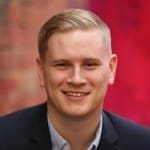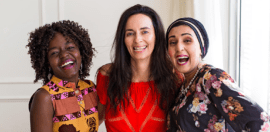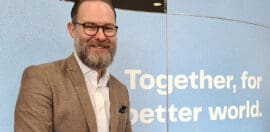NFPs Need to ‘Imagine’ More from Creative Community
20 January 2015 at 11:10 am
The Australian man behind one of the biggest charity campaigns ever has called on Not for Profits to start making better connections with advertising and marketing agencies.
David Ohana is originally from Sydney but now lives in New York where he works as the Head of Global Branding for international children’s charity UNICEF.
Late last year he headed up a team that launched the organisation’s Imagine campaign.
The campaign was launched in November last year when a video of 100 people, including celebrities, athletes and diplomats singing sections of John Lennon’s song Imagine, was revealed.
It was released to coincide with the 25 year anniversary of the United Nations Convention on the Rights of the Child.
Ohana told Pro Bono Australia News that anyone from around the world could download an application which would allow them to record their own version of the song and the awareness raising campaign would culminate in a final video featuring every version recorded, to be released later this year.
Ohana said every time someone records their take on the song, $1 is unlocked and contributed by UNICEF’s partner companies, with the money going towards funding the organisation’s work.
“With any sort of collaboration like this we’ve had the support of some really great music, production and entertainment teams who all came together around the challenge of how do you reinvent the tradition charity song. The old model is you get a bunch of well known singers in a studio in front of microphones and they record a track,” Ohana said.
“We asked the question, “what does the 2014 and 2015 version of that look like?” And the answer was to use new technology and social media to actually enable people around the worked to record a song with their favourite artist. So it sort of democratises the process of the creation of a new piece of music.
“The most interesting part that we’re starting to see happening all over the world is people in countries everywhere adding their voices to the track, so every day we’re getting new contributions from countries that are getting evolved.”
Ohana said people from some of the furthest reaches of the planet had already recorded their own versions of Imagine, including an Italian astronaut who recorded it in the International Space Station.
“So far there have been people from over 60 countries that have lent their voice and recorded their version of Imagine,” he said.
“We hope that by the time the campaign is finished in September this year that we have people represented in every country as well as some really unlikely people in unlikely places.
“The mammoth and exciting challenge ahead is how to then bring all of those voices together in the creation of a brand new track, the world version of Imagine, which both the video and the song will bring all those voices together in support of child rights.”
Ohana said the campaign had been timed perfectly in order to thrust issues affecting children into the limelight.
“2015 is a pivotal year as world leaders will be meeting at the UN General Assembly to develop new millennial goals for sustainable development for the next 15 years and it is important that children are at the heart of those goals,” he said.
“At the heart of the campaign it was originally very much an awareness-raising campaign around what has been achieved over the last 25 years, and there’s been so many areas where there has been great achievement, but there’s still so much work to be done.
“Every day over 17,000 children are still dying from mainly preventable diseases.
“But also, there’s the opportunity for fundraising which will go towards supporting these child rights.
“It creates an interesting proposition whereby the song that was released back in 1971 by John Lennon, who was imagining a better world, now that people around the world are lending their voices to that song, we hope that in a small way that song itself and the recreation of it can can actually lead to the protection of these rights.”
Ohana said the app had already been downloaded 150,000 times.
He said it was still possible for smaller charities with less resources than UNICEF to create a campaign that breaks through and gains traction.
“It all comes down to the power of the big idea,” he said.
“A great idea has a tendency to ignite public imagination and we’ve seen recently with proliferation of social media and other channels, it’s really levelled the playing field for smaller organisations.
“We’ve seen things like the ALS Ice Bucket Challenge and others which have really raised the profile of particular issues in a way that probably wasn’t possible five or 10 years ago.”
But he said it was important to find an idea that works for your organisation.
“I would say start with a compelling and powerful idea,” he said.
“I think it’s about ideas that are authentic, that can spark imagination and gain a lot of free publicity and try to break mould of the traditional way that charities and NGOs reach the public.
“Doing something unexpected and really starting with not the message that the organisation wants to get to the world but learning more about our audiences and hearing what they want from us and working back from there.
“The biggest challenge for all of us working in this space is to find the one or two big ideas and consistently grow them. There’s a tendency to move from one campaign to another and I think it’s about seeing where you can take a simple idea, how it can be replicated and expanded, learning from mistakes and building on that.”
Ohana said Not for Profits needed to look to professionals from the marketing world in order to create better connections with the wider public.
“I’ve been doing this for the last six or so years at the UN and now UNICEF and I really strongly believe that we are not asking as much of the creative community as they want to do for us,” he said.
“So many advertising agencies, PR companies, marketing agencies would like to do more work in this space and often it’s just about providing the right brief, being able to speak in a common language, and I think when you get the collaboration of those two worlds right that’s when you can get results that really can make a difference.
“There’s a really interesting model that’s happening around the world of engaging a creative community, knowing that there are expert storytellers, marketers, PR people and bringing them on board to help us solve some of our communications challenges.
“When you get the right smart and creative people together around the table on a challenge that is meaningful the results can be extraordinary.”







